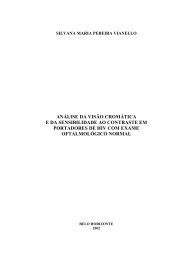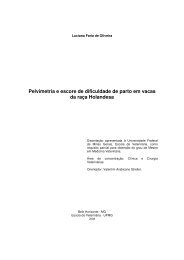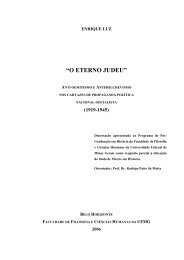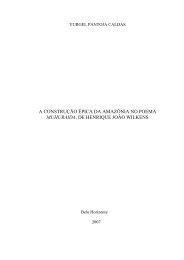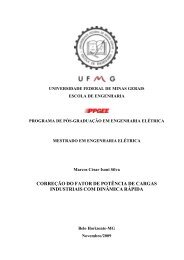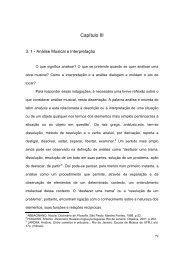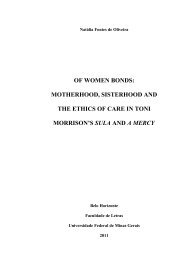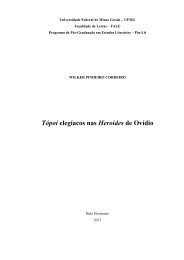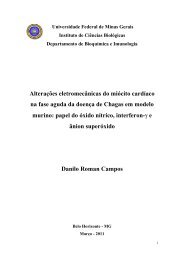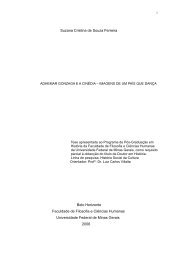efeitos da inibição do sistema renina-angiotensina-aldosterona e do ...
efeitos da inibição do sistema renina-angiotensina-aldosterona e do ...
efeitos da inibição do sistema renina-angiotensina-aldosterona e do ...
You also want an ePaper? Increase the reach of your titles
YUMPU automatically turns print PDFs into web optimized ePapers that Google loves.
ABSTRACT<br />
Chagas’ disease, caused by Trypanosoma cruzi (T. cruzi), was discovered and reported by<br />
Carlos Chagas, a Brazilian physician, in 1909. Unfortunately, near to a century since its<br />
original description, it continues to represent a terrible impact on humanity. Chagas’<br />
myocardiopathy pathogenesis and consequent heart failure <strong>do</strong> not seem to differ from other<br />
forms of idiopathic and ischemic myocardiopathy. Bearing this in mind, we consider that<br />
the results of great clinical assays in patients with cardiac insufficiency can be extended to<br />
those carriers of Chagas’ cardiomyopathy. Even though it is admitted that pathophysiology<br />
of Chagas’ cardiomyopathy is similar to non-chagasic myocardiopathy, there are many<br />
peculiarities in Chagas’ myocardiopathy. For this prospective study, we selected a group of<br />
42 patients with chronic Chagas’ cardiomyopathy (CCC). The selection was made<br />
consecutively among patients assisted in the Ambulatório de Referência em Doença de<br />
Chagas <strong>do</strong> HC-UFMG (Reference Ambulatory in Chagas’ Disease of the Teaching County<br />
Hospital of the Federal University of Minas Gerais). The premise used for the selection<br />
was the presence of the left ventricle diastolic diameter (LVD) larger than 55mm or 2.7<br />
cm/m2 and at least one of the following criteria: left ventricular ejection fraction (LVEF)<br />
smaller than 55% (modified Simpson) or evidence of diffuse or segmental systolic<br />
dysfunction. Patients with any co-morbidities, which might have caused confusion to the<br />
<strong>da</strong>ta analysis, were excluded. The primary aim of the study was a change in the LVEF after<br />
renin-angiotensin system inhibition (RASi) and after addition of carvedilol. Secon<strong>da</strong>ry<br />
objectives were changes in clinical, life quality, radiological, neurohormonal (BNP), and<br />
inflammatory (RANTES, MCP1, and MIP1α) parameters, as well as the behavior of the<br />
anti-adrenergic and anti-muscarinic antibodies. The study was divided in two phases:<br />
Phase I was named RASi and the second one, carvedilol/placebo. These patients were<br />
assessed for clinical, life quality, radiological, ECG, neurohormonal and inflammatory<br />
aspects in the beginning and at the end of each phase. The protocol of <strong>do</strong>sage optimization<br />
of enalapril (20 mg BID) and spironolactone (25 mg MID) was applied to the selected<br />
group. Subsequently, the group was ran<strong>do</strong>mly assigned to a carvedilol group (n=19) and a<br />
placebo group (n=20). Both were uptitrated to use carvedilol or placebo 25mg qd. The<br />
utilization of other drugs, such as furosemide, hidroclorotiazidics, digoxin and amio<strong>da</strong>rone<br />
were guided in accor<strong>da</strong>nce to clinical requirement, respecting their basic indications and<br />
restrictions. In phase I, it was observed that the therapeutic optimization was safe and<br />
efficient, being characterized by a meaningful improvement on the clinical examination<br />
(Framingham score – p = 0.0004), life quality, radiological (reduction in the cardiothoracic<br />
index – p = 0.002) and echocardiographic parameters (improvement of the index TEI – p =<br />
0.013). Regarding the analysis of the differences of the LVEF (p = 0.249) and the LVD (p<br />
= 0.335) before and after RASi, statistical significance was not observed. However, when<br />
patients were rated according to the degree of systolic dysfunction (EF < = 45%), a<br />
significant difference was observed (p = 0.017) between the two variables prior and after<br />
the optimized treatment. BNP and RANTES levels decreased and antiβ1 receptor antibody<br />
levels increased significantly (p = 0.032; p = 0.001; p = 0.020, respectively). After the<br />
association of carvedilol, it was observed a trend towards an increase in LVEF (p=0.066)<br />
in the carvedilol group, but not in the placebo group (p=0.241). The difference between<br />
these groups also showed a trend to significance (p=0.09). After the association of<br />
carvedilol, there was no additional improvement on clinical, life quality, and<br />
neurohormonal parameters, but there was no criterion of worsening as well. However, it<br />
was not observed clinical or hemodynamic worsening. RANTES levels showed significant<br />
increase (p=0.013), but there was no difference between groups (p=0.351). The<br />
antiβ1receptor antibodies showed a trend to additional rise (p=0.050) with significant



